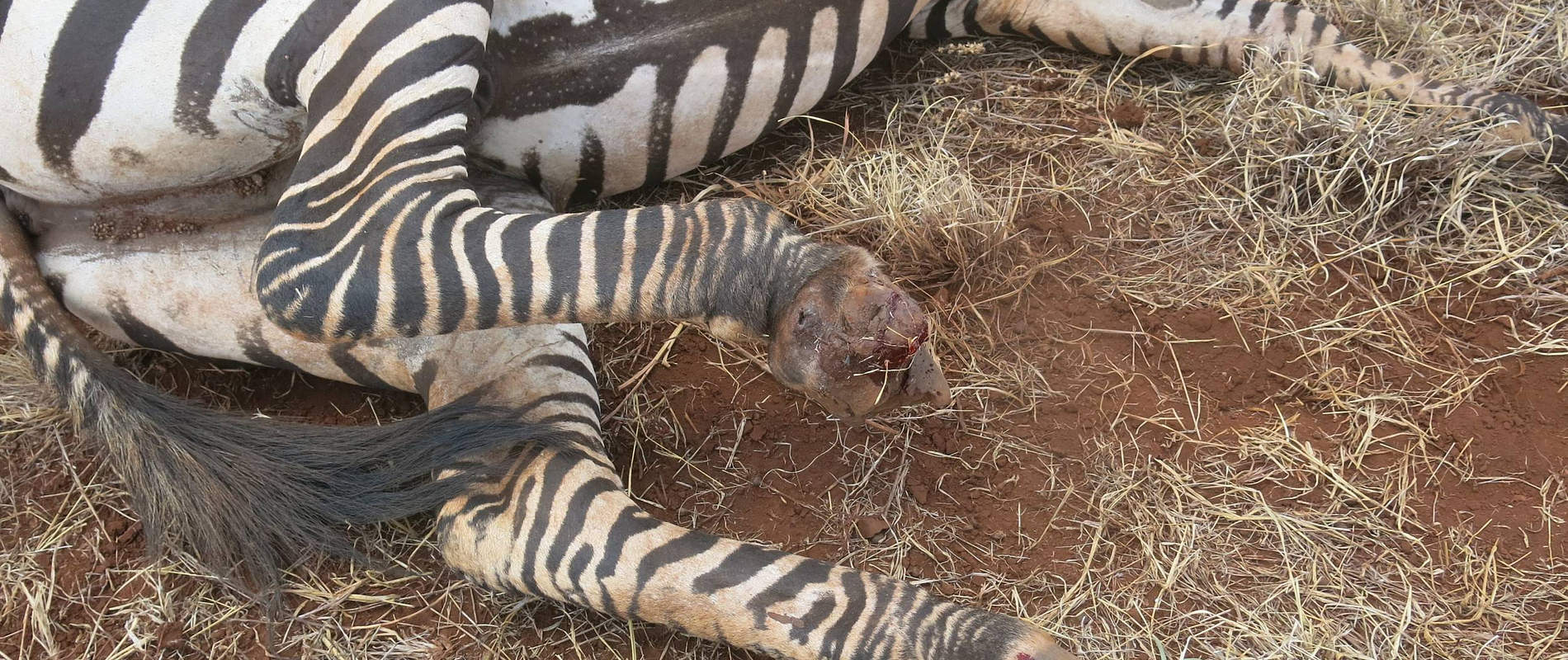EASTERN CONSERVATION AREA VETERINARY UNIT MONTHLY REPORT MARCH 2017 Report by: Bernard Rono Summary This report describes the activities of the Meru Veterinary Unit in Northern Kenya in March 2017
EASTERN CONSERVATION AREA VETERINARY UNIT MONTHLY REPORT MARCH 2017
Report by: Bernard Rono
Summary
This report describes the activities of the Meru Veterinary Unit in Northern Kenya in March 2017. Drought continues to affect many parts in the eastern part of Meru, Samburu and Laikipia. This has caused a reduction in pasture and water resources for both wildlife and livestock.
We attended to the following cases: In Meru national park a reticulated giraffe was immobilized to remove a wire snare and four elephants were treated for injuries ranging from a gunshot wound, a spear and fracture of the thigh bone.
The Meru Veterinary Unit is supported by the David Sheldrick Trust to provide veterinary care in northern Kenya.
CASE # 1: SNARE REMOVAL IN GIRAFFE
Date: 8th March 2017
Species: Reticulated giraffe
Sex: Male
Age: Adult
Location: Meru national park
History
A giraffe showing lameness caused by a debilitating snare on its left hind leg was first seen by rangers on patrol in Kinna triangle, Meru national park on 6th March 2017. Following this report the Meru vet unit searched for and immobilized this giraffe for treatment on 8th March 2017.
Immobilization, examination and treatment
Immobilization was achieved using a combination of Captivon® and Azaperone tartate delivered in a 1.5cc Dan-Inject dart from a vehicle. The drugs took effect after 8 minutes and it was roped to lateral recumbence for examination and treatment.
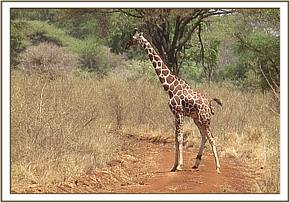

Examination showed a septic wound caused by a plain wire snare that had cut through the skin, muscle and tendons on the right metatarsal.
Treatment involved snare removal using a wire cutter, wound debridement using Hydrogen peroxide, application of iodine antiseptic and green clay paste. An antibiotic and anti-inflammatory drug was also administered.
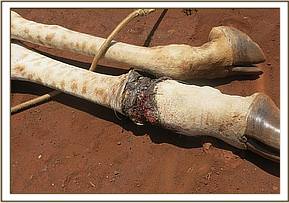

Reversal and Prognosis
Complete reversal of the anesthetic was achieved by intravenous administration of Naltrexone® hydrochloride through the jugular vein. Two minutes later the giraffe was in a standing position and ran into the bushes. We expect that the injuries will heal following removal of this harmful snare.
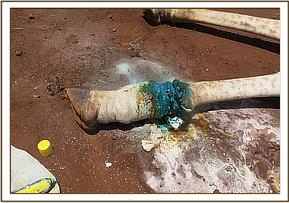

CASE # 2: LAMENESS IN A ZEBRA
Date: 8th March 2017
Species: Common zebra
Sex: Male
Age: Adult
Location: Meru national park
History
The Vet Unit discovered this injured zebra in Meru national park while searching for a snared giraffe on 8th March 2017. The zebra showed lameness of its left hind leg.
Immobilization, examination and treatment
A combination of Captivon® and Azaperone tartate was used to immobilize this zebra. The zebra was darted from a vehicle with the dart placed into the gluteal muscles. Three minutes after darting the zebra was recumbent. A blindfold was applied and the zebra was positioned on left lateral recumbence for examination.
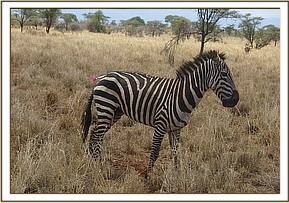

Examination showed that lameness was caused by traumatic lateral hoof amputation of its right hind leg. An abscess with a sinus tract around the coronary band was also observed. These injuries may have been caused by a snare which dropped.
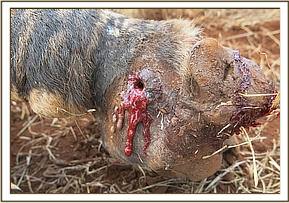

The abscessed was lanced and drained and hydrogen peroxide applied to remove necrotic tissue. An antibiotic and anti-inflammatory drug was also administered.
Reversal and Prognosis
The effect of anesthetic was reversed by intravenous administration of Naltrexone hydrochloride through the jugular vein. This zebra will regain good health though it will remain lame due to the deformity on its leg.
CASE # 3: RELOCATION OF A CHEETAH
Date: 9th March 2017
Species: Cheetah
Sex: Male
Age: Adult
Capture site: Garissa
Release site: Meru national park
A cheetah was captured by the KWS station in community land in Garissa where it was involved in livestock depredation.


The Veterinary Unit was present to assess the health of the animal and assist with the relocation. It was relocated to Meru national park and released along Mulika swamp.
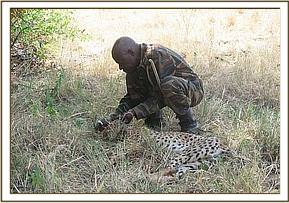

CASE # 4: SPEAR REMOVAL IN ELEPHANT
Date: 15th March 2017
Species: Elephant
Sex: Male
Age: Adult
Location: Loisaba conservancy
History
Wildlife scouts in Loisaba conservancy, Laikipia found an elephant which had a spear penetrating into its left rump. The conservancy manager contacted Meru veterinary unit for assistance to treat this elephant.
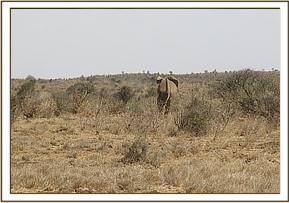

Immobilization, examination and treatment
The Veterinary Unit found this elephant in a thicket near the Conservancy Headquarters. The terrain here was rocky so the elephant had to be driven out using vehicles to a plain open grassland area. The elephant was successfully darted from a vehicle after a brief chase using 16mg Captivon® and induction time was six minutes.
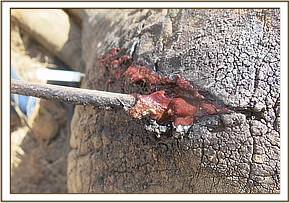

The one and a half foot spear had penetrated through the left gluteal muscles and was carefully removed. Necrotic tissue was removed manually and flushed with Hydrogen peroxide. Povidone iodine and green clay was also applied. A long acting antibiotic was given by intramuscular route.
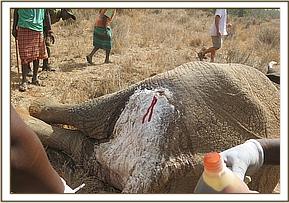

Reversal
To reverse the anesthetic effect, Naltrexone® hydrochloride was injected intravenously through the superficial ear vein. Though the injuries were life threatening if left untreated, we are hopeful this elephant will recover fully after treatment.
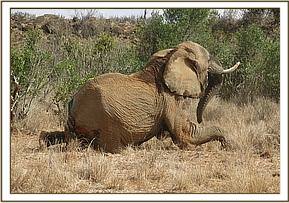

CASE # 5: LAMENESS IN A WHITE RHINO
Date: 21st March 2017
Species: White rhino
Sex: Male
Age: Adult
Location: Lewa wildlife conservancy
History
The Meru Veterinary Unit provided technical support to the KWS veterinarian in Lewa to immobilize and treat a white rhino which showed lameness of its right leg.
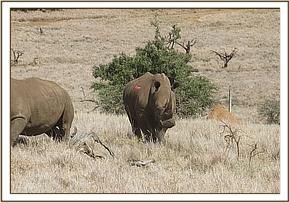

Examination and treatment
Examination of the affected leg showed traumatic removal of the toe nail. The wound was thoroughly cleaned before iodine was used to disinfect the wound and a pressure bandage applied. Anti-inflammatory and antibiotic drugs were also administered.
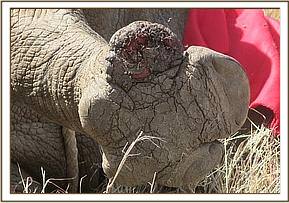
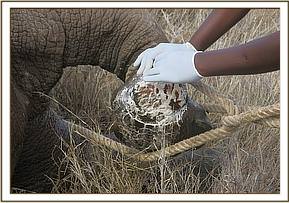

Prognosis
Prognosis is good
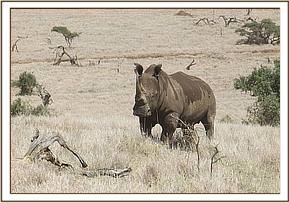
CASE # 6: RECUMBENT ELEPHANT AT OLE NAISHU
Date: 26th March 2017
Species: Elephant
Sex: Female
Age: Adult
Location: Ole Naishu ranch
History
On 26th March, the KWS senior warden in Laikipia reported that a female elephant in Ole Naishu ranch was recumbent for more than 12 hours and needed urgent veterinary assessment. This female had a calf estimated at less than 18 months old which was still dependent on its mother for nutrition and protection.
Physical examination
On arrival we found a comatose elephant with its male calf and a herd of six surrounding it. Observation showed severe emaciation, dehydration, and anemia. There was a septic wound penetrating into the muscles of the right forelimb from the medial aspect. Manipulation of the leg revealed a fracture of the radius bone. These findings are consistent with gunshot injuries.
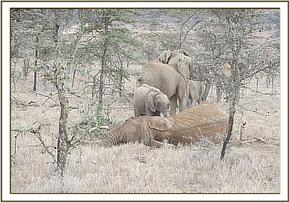

Case management
This elephant had a poor prognosis for recovery due to the severity of the injury and we recommended euthanasia to relieve suffering. Though its male calf joined the herd, we recommended close monitoring and if it is abandoned it should be rescued and taken to an orphanage.
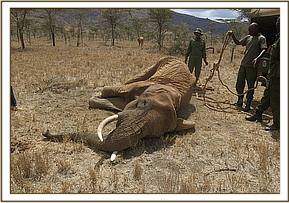

CASE # 7: LAMENESS IN ELEPHANT IN NGILAI
Date: 27th March 2017
Species: Elephant
Sex: Female
Age: Adult
Location: Namunyak conservancy, Ngilai
Rangers in Ngilai reported severe lameness in a female elephant affecting the left hind leg. Community reported that this elephant had its leg trapped in a rocky crevice on the Mathews range but later freed itself. A veterinary assessment was required to determine the extent of injury and treat this elephant.
We tracked this elephant to a thicket in steep and rocky terrain where darting was not safe. Observation showed severe injury affecting the left hind leg, the elephant was able to walk for short distances with a hopping gait and could not charge at us even from close range. It had a huge swelling on its thigh and the thigh bone seemed unstable suggesting a fracture. Recommendation:
CASE # 8: LAMENESS IN ELEPHANT
Date: 28th March 2017
Species: Elephant
Sex: Female
Age: Adult
Location: Namunyak conservancy
History
Namunyak conservancy reported lameness in a lactating female elephant which had a one year old calf. We immobilized this elephant for examination and treatment on 28/03/17.
Immobilization, examination and treatment
For immobilization we used Captivon® 18mg delivered in a 3 milliliter Dan-Inject dart. The elephant was darted from foot after tracking the elephant in a lugga. Induction time was seven minutes and the elephant fell onto right lateral recumbency.


Examination showed a deformity of the left hind leg. It had a swelling on its left stifle joint which was shorter than its right hind leg. Palpation revealed a hard mass deduced as bone. This deformity was caused by a healed dislocation/ fracture. Anti- inflammatory drugs were injected and the animal revived.
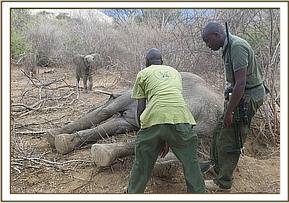

Prognosis
Both mother and calf were in good health
